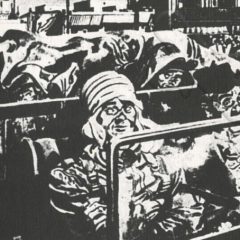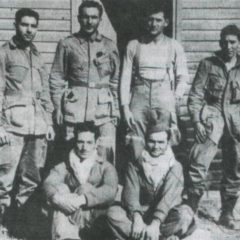Since November 15, Raff and its troopers of 2/509 hold two airfields : Tebessa and Youks-les-Bains. He was chaffing with the thought that his paratroopers were just sitting around guarding an airfield when there was a war to fight. For him, his two combat jumps were not enough.
He wants to venture into Tunisia and for this he plans to approach Gafsa, south of Kasserine. Between them and Gafsa are only about thirty french of the 3rd Zouave Regiment with old armored vehicles. The idea is to go and occupy this city before the Germans go to Tebessa. After several negotiations, Raff got the permission to only carry out a reconnaissance.
He then requisitioned two buses with the appearance of wreck. He puts 20 troopers in each, with two men on the roof and a .30 cal. He crossed the border on 17 November and traveled 150 kilometers to Gafsa where he joins the 3rd Zouave Regiment.
Together, they will undermine the railroad tracks and the surrounding accesses of the city. But after two days, the situation in southern Tunisia is deteriorating. The Germans landed in Gabes, and armored columns converged from Tunis to Sousse and Kairouan. On November 20, Raff received confirmation that an Italian-German armored column had left Kairouan for Gafsa. Reinforcements requested by Raff at the First Army Headquarters did not arrive. In Gafsa there are 160,000 liters of gasoline and a depot of ammunition. The troopers place explosives there, and are preparing to leave Gafsa so as not to be cut off from their rear. At 3:20 am on the 21, Raff orders the withdrawal, and the demolition of fuel reserves. He arrives in Tebessa before the rising of the sun and desperately waits for reinforcements.
Fortunately, the I Company and the Antitank Platoon of the 3/26th Infantry Regiment arrive at Youks-les-Bains by C-47 from Algiers. The B Company of the 701st Tank Destroyer Battalion also arrives in the afternoon after a long journey from Oran.
At the head of his small army, nicknamed Raff 'Ruffians, Raff attacked Gafsa on 22 November with the help of P-38 fighters. The tank destroyers open fire with their 75mm and the infantry follows behind the half-tracks. Gafsa is quickly recaptured, but most of the German paratroopers who held the town escaped to the south. Two German paratroopers are taken prisoners. Only a French vehicle is lost after driving on a mine.
But on returning to Gafsa, Raff and the French discovered that during the brief German presence, plunderers made terror reign with the French population, raping and plundering, with apparently, the blessing of the Nazis. 39 Arabs are arrested and executed by the French.
The next 24 hours would send the Tunisian Task Force on an almost 100 miles front. It is not yet clear where they are going to send this fighting group when a message is sent informing that an enemy armored force is approaching dangerously from El Guettar, south of Gafsa. Raff then formed an armored force/infantry and made the 20 miles to El Guettar. In this commitment, the destroyers destroy five armored vehicles. The following night, Raff ordered B/701st reinforced by toopers to go to the aid of the French north to Ferriana where enemy tanks and infantry were seen. Not encountering any enemy vehicles; The unit goes up to Sbietla and finds itself face to the enemy force. A short but violent battle ensues where 20 enemy tanks are destroyed, three trucks are recovered and a hundred prisoners are made. Most of the prisoners are Italian because the Germans retreated when the fate of the battle began to befall them. From there, the Tunisian Task Force moved to Ferriana from 25 November. From there it began to function as a mobile force, capable of reaching every sector where it is called in four or five hours.
In Tunisia, the vast majority of Afrika Korps supplies are transported by train. In order to stop these refueling operations, the Allies launched a bombing campaign against all major roads and railroads. All the air raids had failed because of a very rough terrain. El Djem bridge is so small that the bombardments are also imprecise. The idea is then to send a small commando to dynamite the bridge which is located on the track between Sousse and Sfax, a few hundred kilometers behind the front lines. The French claim that no train travels on this railway. But the Allied High Command decided otherwise, and the order was given to send a commando to dynamite the bridge.
At 10.30 pm on 26 December 1942, 3 C-47s took off from Thelepte in Tunisia under a full moon. On board, 30 men of the 2/509th Parachute Infantry Battalion and two French (Sergeant Jean Guilhenjouan and Corporal Paul Vullierme) are supposed to know the country. Their mission was to destroy the El Djem railroad bridge, which was vital for the transport of supplies to the Afrika Korps in El Djem.
In addition to their usual equipment, for this mission, the paratroopers receive an escape kit containing a saw, fishing gear, small magnetic compasses and matches. The flight lasts about 1 hour to cover the 144 kilometers. The pilots have difficulty locating the jump area to be located north of the track. The C-47s then turn over El Djem before heading north along the tracks until they reach the drop zone.
When the green light comes on, the paratroopers jump and undergo a sudden landing due to the darkness. However, the group collects quickly even if the paratroopers put an hour to recover all the equipment. They quickly find the railway and then walk south thinking they quickly reach their goal. After three hours of walking, the group stops to rest and De Leo sends scouts south to find the bridge. Thirty minutes later, they return without finding the bridge. As the sun begins to rise, the group continues its march to the south.
He then discovers the horrible truth; They had walked in the wrong direction all night. The paratroopers can not turn back because of the fatigue of the men and then explode a piece of railway track and a building seemingly enclosed a mechanism of railway control. During the destruction operation, watchmen north and south of the railway track, saw the Germans just over a kilometer from their position. They were betrayed by Arabs to whom they had asked to retrieve and transport the equipment as well as to orient themselves.
With the Germans approaching, De Leo explains that it is necessary to separate to join the allied lines. Of the 32 men of the commando, 7 succeed relatively easily, Sixteen other men will later find the battalion. The rest of the paratroopers, most of them unknown, were killed by the Germans. After the capture of Tunisia, De Leo returned to see the bridge. Built on enormous pillars, he and his paratroopers could never have destroyed it.





